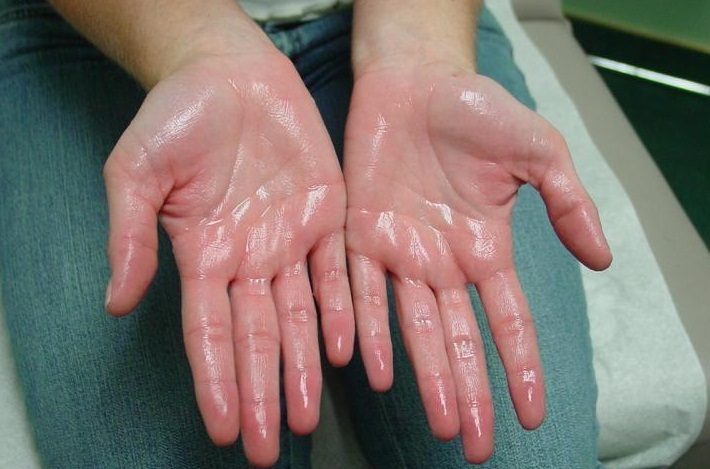Whenever our body temperature increases more than a particular limit, we start sweating. This is basic functionality that helps to cool down our internal system. Without this process, our organs can get damaged due to excessive heat.
But some people start sweating without any reason. This is a medical condition called Hyperhidrosis that can become a problematic condition for such individuals. Apart from creating a disturbance in daily life, excessive sweating can also be a sign of some underlying disease. Thus, it needs to be properly diagnosed and treated by a doctor.
Basic Description
Hyperhidrosis is a medical term for excessive sweating that can happen without any relation to body heat or vigorous exercising. It can be an embarrassing situation for people who are doing some work in the public area.
Such problem is generally associated with the nervous system of the body. This system consists of the brain, spinal cord, and all the nerves that are spread throughout the human body. If something is triggering any region of the nervous system, then it can result in hyperhidrosis.
To cure this problem, the doctor has to run certain tests to find the condition that triggers the sweat glands. It is not a life-threatening situation. However, if sweating is caused by some other disease, then it needs to be treated with proper care.
Symptoms
Hyperhidrosis can disrupt your normal daily routine. It can cause a variety of issues that have a direct or indirect effect on your social life. Some basic symptoms of this medical condition are:
- A high amount of water accumulation in your armpits and back area of the body.
- Clothes becoming completely wet causes uncomfortable situations.
- Need to change your clothing frequently so as to prevent odor and a wet body.
- Avoiding social interactions with people. This includes physical interactions like shaking hands.
- Having red spots in a particular area due to constant scratching of wet clothes.
- Itching in a specific region or the entire body.
- Having dark marks on the body can happen because of bacteria.
- Skin becoming too dry or soft because of water.
- Feet deteriorating over time with cracks and marks spreading over the soles.
Factors Responsible
A variety of factors can be responsible for hyperhidrosis. In a normal human, the sweat glands are only activated when there is a requirement of reducing the body’s temperature. During a stressful scenario, you may observe sweat accumulation in your palms and feet.
The basic form of hyperhidrosis is primary focal. It occurs when there are overactive sweat glands on your body. Such a condition can be related to your genetic behavior or being exposed to some kind of trauma in your life. Your doctor may help you with this condition by prescribing some medications and changing your lifestyle.
The secondary form of hyperhidrosis happens due to some medical disease. Some common causes of such type are listed below:
- Menopause also results in having hot flashes.
- Having low blood sugar levels.
- Heart conditions like heart failure or arrhythmia.
- Being diabetic.
- Formation of cancer in some parts of the body.
- Suffering from infections.
- Having a disorder in the nervous system.
- Certain types of medicines.
Diagnosing the Problem
To diagnose the root cause of hyperhidrosis, the doctor will perform several tests. But before performing any medical examinations, a one-on-one session is conducted. In this, the patient will be asked several questions regarding mental and physical health. If the patient is already taking some prescribed drugs, then the doctor will give a new prescription for them. Also, a psychiatrist can help in reducing stress and anxiety to stop hyperhidrosis symptoms from occurring.
After that, the next step is to perform a blood test using biopsy and urine test. Using such diagnosing procedures, the doctor is able to observe any disease that can cause hyperhidrosis. Medical conditions like hyperthyroidism and low sugar levels can be found using such tests. Additionally, some sweat tests like skin conductance, thermoregulatory test, and iodine-start test are conducted to find the specific regions of sweating.
Treatments Available
During the diagnosis period, if some underlying disease is detected, then that problem is examined and cured before the treatment of hyperhidrosis. Then the doctor will proceed with simple medications for the treatment. Some prescribed drugs that are given to the patient are antiperspirant, nerve blockers, and antidepressants. Botulinum toxin can also be injected to cover the path of nerves that cause sweating.
In addition to this, a patient can ask for removing the entire sweat gland or removing the particular overactive nerves. Both of these treatments require a surgical procedure.
Where to Go?
Hyperhidrosis can be cured by visiting a medical center offering treatment in hyperhidrosis Singapore. Depending on the condition and patient’s requirements, the thoracic surgeon Singapore will conduct a treatment. You can even go for hyperhidrosis surgery Singapore to permanently remove your sweating condition.
